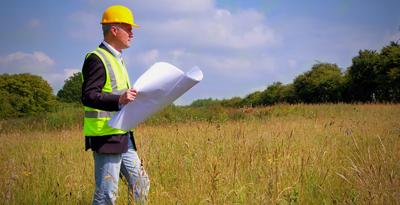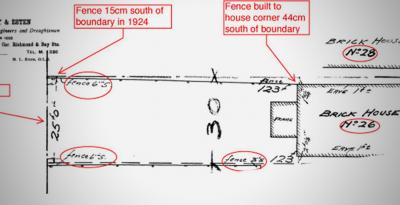Home owner
Can you Earn Income by Building a Laneway Suite? Step 1: Confirm Your Boundaries
On Thursday June 28, 2018, the City of Toronto Council approved a motion to amend a city bylaw which would now allow the construction of laneway suites in residential neighbourhoods. The ever-increasing demand for affordable housing in the GTA played a huge role in the 30 -5 vote, with the hopes that this change will alleviate some of the pressure its residents are having with finding living space.
All about land survey plans
Our last few blog posts have focused on the top four situations where a land survey plan is important: buying a home, selling a home, planning an exterior renovation (building a fence, shed, etc.) and disputing a boundary. Now we’ll look at the land survey plan itself, and the important role it plays in our system of private land ownership, which is based on properties with well-defined boundaries.
The history & importance of land surveying
One of the oldest professions in the world, land surveying emerged along with the human desire to build large structures, from Stonehenge forward. Ancient surveyors plotted the sites of the pyramids in Egypt before the first massive building stones slid into place. The Romans established land surveying as a profession to measure and manage the conquered lands that formed their empire. Both William the Conqueror and Napoleon Bonaparte relied on precise maps to gain wealth and power.
Notable surveyors include Sir George Everest, (yes, that mountain), George Washington and Abraham Lincoln. In what would become Canada, the great explorers – including Samuel de Champlain, James Cook and George Vancouver – began the process of documenting the contours of the land on paper.
A land surveyor's right to enter
Licensed Ontario Land Surveyors and their staff, working within the Province of Ontario, have a statutory right to enter onto private property in order to perform a survey. Despite this entitlement, they often meet resistance: neighbours may object and have been known to call the police to stop what they consider an act of trespass.
The law recognizes certain circumstances when officials of government agencies and inspectors can enter onto private land without a search warrant. But this access is subject to limitations. Even fire firefighters and emergency medical services staff must abide by certain conditions when entering private land during an emergency.
Are Survey Plans Obsolete or The Most Important Document in the Transaction? Bob Aaron speaks.
On April 22 2015 the Law Society of Upper Canada is holding the 12th Annual Real Estate Law Summit in Toronto.
Bob Aaron, lawyer and Toronto Star columnist, will be speaking on the importance of the land survey plan in today’s real estate transaction.
Why a survey plan should be in your home selling package
Today’s savvy homesellers understand the value of showing their home in its best light. “Staging” a home by eliminating clutter and adding tasteful artwork, neutral paint colours and optimal furniture arrangements has become routine in the hopes of attracting multiple offers and higher bids.
There is less awareness about the importance of including a property survey plan in the home information package. While the Agreement of Purchase and Sale (APS) contains a standard condition that allows the purchaser to request that the seller supply a survey plan if they have one in their possession, there is much confusion regarding this clause and what precisely the vendor will produce.
Top 5 boundary Q&As
The first step to protecting your boundaries is to become informed about your rights as a private property owner. You have the right to exclusive use of your property, the right to legal protection against others intruding on your property, and the right to sell, transfer, exchange and mortgage property.
Land surveying – the art and science of mapping and measuring land, and calculating the precise locations and boundaries of divided plots of land – makes our system of private property ownership possible. Protect Your Boundaries was created to provide homeowners with the tools and information they need to safeguard their property assets. To that end, this blog post will provide answers to the top five boundary questions.
What are squatter's rights in Ontario?
It is human nature to test limits, and the realm of property boundaries is no different. Neighbours sometimes encroach on a boundary accidentally, and other times quite willfully. It can involve moving a fence a few feet inside your property line, improperly locating a new backyard shed or pool, or repaving and widening a driveway onto your property and hoping you will not notice or object.
In fact, people who have been occupying a portion of your land for several years in this manner may come to regard it as legally
belonging to them – a situation termed “squatter’s rights” in popular culture.
Get property boundary answers at fall home show
Where are my property boundaries?
Where does the fence go?
What can I do about a property boundary dispute with my neighbour?
If you have property boundary questions or concerns – or simply want to learn more about why a land survey plan is such an important homeowner document – be sure to check out the Protect Your Boundaries (PYB) booth (#909) at the Toronto Fall Home Show Sept. 18-21.
49% of GTA properties have ‘boundary time bombs’
Approximately 49 per cent of residential properties in the Greater Toronto Area have property boundary discrepancies that could lead to disputes between neighbours, a study by PYB shows.
A random sample of 415 land survey plans from the City of Toronto and the regional municipalities of Durham, Halton, Peel and York revealed that 205, or 49 per cent, of the properties have a misplaced fence or other encroaching structure or occupation issue with the potential to create conflict between neighbours.






















